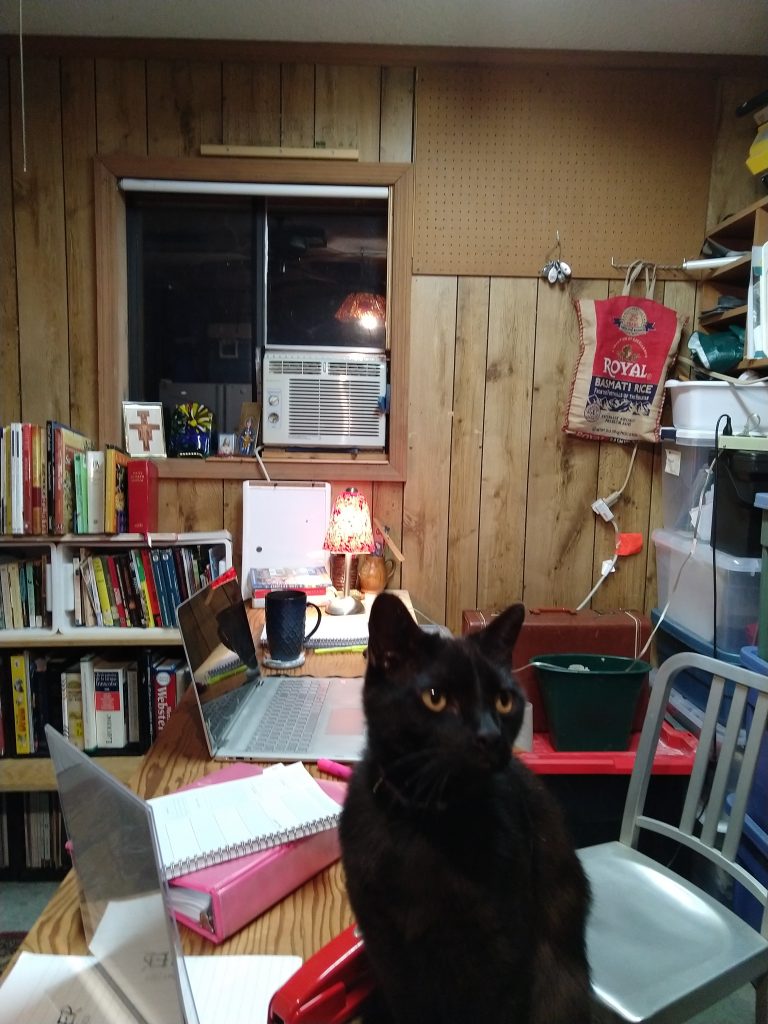Today’s topic is not a newsflash, but there might be someone out there who could benefit from hearing it again, this time with a little common-sense consolation thrown in.
***
So I’ve been running experiments on myself, and can confirm: Custody of the eyes works wonders.
You may recognize the term from chastity talks. For some of you, your introduction to the term was not during a kind of chastity talk you found very edifying; others may have had the opposite experience. Anyhow, we aren’t talking about sex today. Not even one bit. Deep breath.
***
If you’re new to the term, “custody of the eyes” means taking steps to avoid leading yourself into temptation. It refers specifically to choosing not to look at things that tempt you, but the concept expands to all the senses, physical and otherwise.
What kinds of things, other than sex since we are not talking about sex, might be tempting?
- Eating that one kind of chips in the variety pack that your kids weirdly don’t like, even though they are the best flavor, and doing that eating despite the fact that there is no medical evidence your body would benefit, for any reason whatsoever, from eating another such chip again in your life.
- Arguing manically with your beloved internet friend who is usually awesome, but happens to be horribly, horribly wrong about something. In your opinion.
- Buying that perfect wardrobe item that you do not need because your closet is already full of other good-enough shoes and clothes and hats, ahem, but it’s a really good deal and it is so cute/practical/snazzy/fantabulous, but seriously: You don’t need it, and that money would do more good applied someplace else.
Perhaps you face other temptations as well. They could be temptations to do something that is always sinful under all circumstances, or they could be temptations that are sinful only because of how they affect you personally (example: a calmer spirit might be able to discuss that contentious issue without getting worked up into a frenzy), or they could be temptations that aren’t objectively sinful at all (buying that hat, if it’s part of your responsibly-budgeted splurge fund, and also it’s an awesome hat), but which sabotage your other, better goals.
We aren’t, on that last point, talking today about scrupling, where you obsessively worry that some harmless action is gravely sinful. We’re just saying: For whatever reason you’ve determined that xyz action is not the way you want to live . . . and yet you’re tempted to do it anyway.
Enter one tool to include in your spiritual toolbox: Custody of the eyes.
***
“Custody of the eyes” means you take steps to change the way you are living in order to not be as tempted as you otherwise might be. In emergency-mode, it means that if you’re walking past the hat store, look the other way. My, what fabulous road work the city is doing this morning!
But you don’t want to live in emergency-mode all the time.
This is what it’s like living in the land of temptation, true story:
- You’ve determined, for good, sound, scientific reasons, that you would be happier and healthier if you did not eat the chips. Not the lousy chips, and not the fabulous flavor of chips that your children weirdly do not eat, even though the manufacturer has so generously included them in the variety pack that is the best price at your local mass-market merchant.
- 99% of the time, you are able to practice amazing willpower! You walk by the chips, sitting out on the kitchen shelf where your children can easily access their school lunch supplies, and you don’t even think about grabbing just one tiny bag of chips even this once.
- Alas, given enough minutes/hours/days/months, you must run the chip-gauntlet 100 times. Your 99% success rate in avoiding temptation is not quite enough.
You don’t need to beat yourself up over this. It’s a tiny bag of chips. You aren’t allergic. They aren’t actually made of poison, despite the inflammatory rhetoric you read on that one healthy-eating website. It’s fine. But why live this way? Why constantly add to your already busy day that mental struggle? You want to eat fewer chips because you are certain you’ll be happier and healthier that way, and yet having to constantly look at the chips and make yourself not eat them isn’t exactly filling you with joy.
You don’t have to choose between those two fates.
You can put the chips in your teenager’s ancient minivan and instruct her to take them to school and give them to her friends — the ones who have the sense to know what the good flavors are, thanks.
***
Practicing strategic avoidance is life-changing.
When you make small changes to reduce the number of times in a day you have to battle against yourself, you free up so much energy for other efforts.
When you don’t or can’t make those changes — we aren’t in control of the whole world and all that happens around us — you are left working harder to accomplish less.
So let’s talk about a healthy philosophy of can’t.
***
You are not the supreme ruler.
In your life there are many things you can control. Maybe you can change your route to not walk past the hat store. Maybe you can uninstall the social media app that’s always sucking you into the outrage machine. Maybe you can move the deep freezer with the kids’ ice cream in it out of your new library in the old garage and down the hall to the laundry room you don’t visit nearly so often (sorry kids, I am not your ice cream bank; readers, we’ll discuss my laundry backlog some other time).
But you cannot necessarily always make the change you wish you could.
You might be able to convince your colleagues not to put the snack tray out in the hallway next to your desk, but maybe you can’t.
You might be able to automate some of the social media work you do, but maybe it’s impossible to carry out your career in a communications industry without actually, go figure, communicating with people.
You might be able to drop catalogs into the recycle bin without ever looking at them, but maybe you also have to sometimes purchase necessary items, and you really can’t help that the best vendor also sells hats.
You probably face a mixed bag of struggles. Whether you’re working through serious addictions or just trying to live a somewhat more tranquil life, there is only so much reorganizing of your life that you can do.
Do the amount of temptation-reducing that you can, of course. Be creative. Be willing to take drastic measures if you’re struggling with a danger to your spiritual, emotional, or physical health.
After that? Give yourself credit for the battles that are still left.
***
Living your life in emergency-mode temptation-fighting is exhausting. If your choice is, for example, paying the bills by going to that job with the perpetual snack tray always sitting out, or serenely sinking into bankruptcy due to unemployment, you have to go do the job. You have to spend all day passing the snack tray and telling yourself no and walking quickly and trying not think about it.
That stinks.
It’s hard work.
Realistically you are not going to have as much emotional energy for other spiritual activities after you’ve put so much willpower into avoiding the snacks as best you can using the only tool available to you at this time.
Acknowledge it.
Acknowledge that at this time in your life, you are running a spiritual marathon ten hours a day. By fighting the good fight you are getting stronger — even if one time in a hundred you pass the snack table and cave — but you are getting stronger by working out. Just like physical exercise, the spiritual and emotional exercise of resisting temptation is tiring.
Your capacity for that work can grow, but it can’t be instantly expanded to infinity.
So if your circumstances are such that you must constantly battle temptations you can find no way to avoid, applaud yourself for the work you are doing.
***
And of course, final note for those readers who aren’t presently dealing with this kind of practical struggle . . .
If you have been blessed with a low-temptation lifestyle, avail yourselves of the three pillars of the spiritual exercise regimen: prayer, fasting, and almsgiving. Otherwise your soul will grow flabby for want of spiritual work.

I was going to find a good hat picture to illustrate this post, but today’s Wikimedia Image of the Day is too beautiful to skip. Photo of horses grazing in Parco Naturale Tre Cime by kallerna, CC 4.0. Click through and scroll down for some related close-ups.









